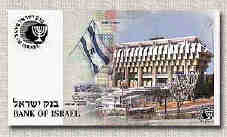|
The question of creating a central bank, or as it was called, the State Bank, was discussed in the Ministry of Finance in 1948, immediately after the establishment of the State of Israel. The matter was shelved due to the pressure of events, but an immediate solution was required to the problem of issuing a currency for the young State. Thus the Bank Notes Ordinance, 5708-1948 was introduced, becoming effective on August 17, 1948. The ordinance defined the authority to issue banknotes in a charter between the government and the Anglo-Palestine Bank, later Bank Leumi Le-Israel B.M. Under the terms of the charter, the Anglo-Palestine Bank set up a special department, the Issue Department, whose task was to issue banknotes. At the same time, the Bank also formed a department to manage State loans. The process of replacing the notes of the Israel Currency Council with those of the Anglo-Palestine Bank began immediately after the Bank Notes Ordinance went into effect and the charter was signed, and was completed by the end of October 1948. The other functions for which a central bank is usually responsible-monetary policy, banking supervision, etc.-were at that time the responsibility of the Ministry of Finance. In March 1951 the Minister of Finance, Eliezer Kaplan, appointed the Committee for the Establishment of a State Bank. The committee, which he headed, submitted its findings in September 1952. These consisted of general recommendations in two areas -the organization of the bank, and the relationship between the bank and the government. The report provided the basis for the preparation of the Bank of Israel Law, which was coordinated by the first Director-General of the Ministry of Finance, David Horowitz, subsequently the first Governor of the Bank of Israel. The major issues dealt with were defining the relationship between the central bank and the government, and guaranteeing the Bank's independence. The Bank of Israel Law, 5714-1954 was passed by the Knesset on August 24th, 1954, and became effective on December 1 of the same year. On that date the Bank of Israel was officially established. The Law replaced the Bank Notes Ordinance of 1948 and other legislation introduced by the Provisional Council of State, which had hitherto regulated the subjects which became the responsibility of the central bank. Once established, the Bank of Israel took over the Issue Department of Bank Leumi Le-lsrael B.M. and the Banking Supervision Department of the Minister of Finance. Foreign exchange control was transferred to the Bank of Israel in 1978. The Bank of Israel is situated in Kiryat Ben Gurion in Jerusalem, close to the Knesset (Israel's parliament), the Supreme Court, and government ministries. The Bank also has a branch in Tel Aviv (in Lilienblum Street). An extension of the Banking Supervision Department is also situated in Tel Aviv (in Yavneh Street). The Bank currently (2001) has some 800 employees, about 300 of whom have degrees in economics, accountancy, law, etc. In the 1980s and the 1990's the Bank underwent radical restructuring, and the number of employees was cut by about one third. This cutback was made possible by more efficient work methods, improvements in the Bank's computer systems, and also by reforms in the capital and money markets which reduced the Bank's involvement in the areas of directed credit, State loans, and foreign exchange control. |
